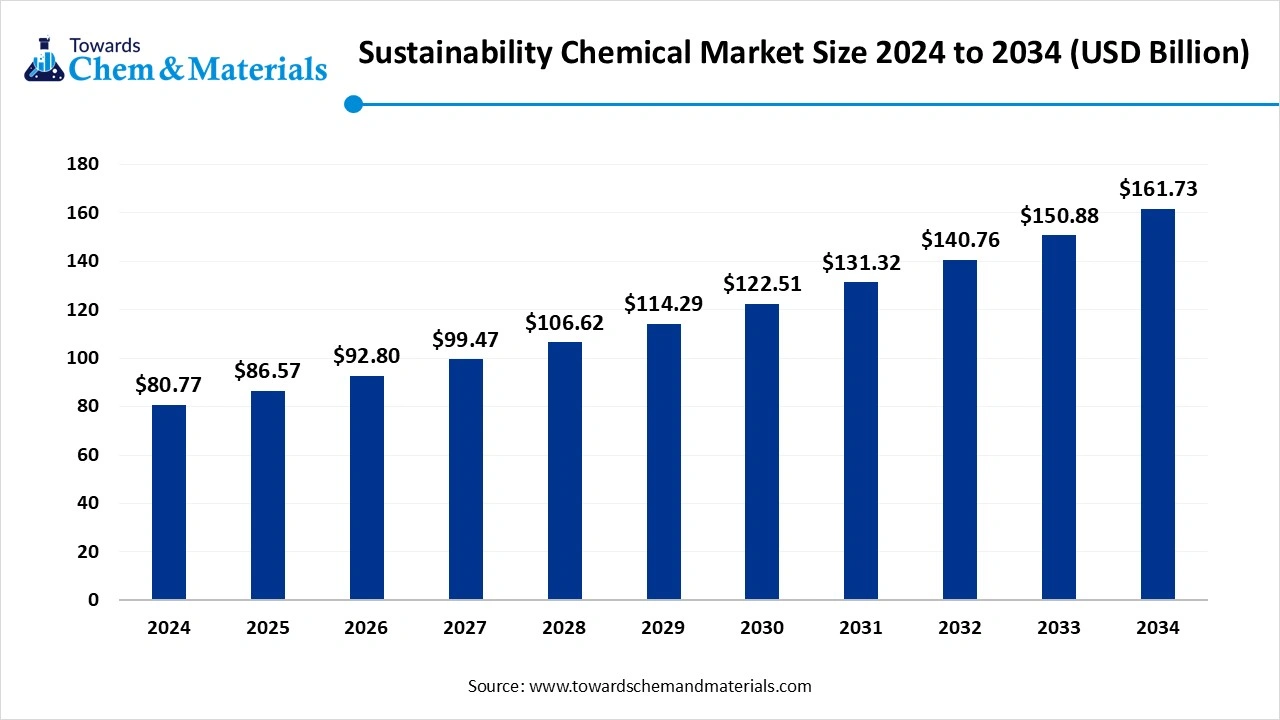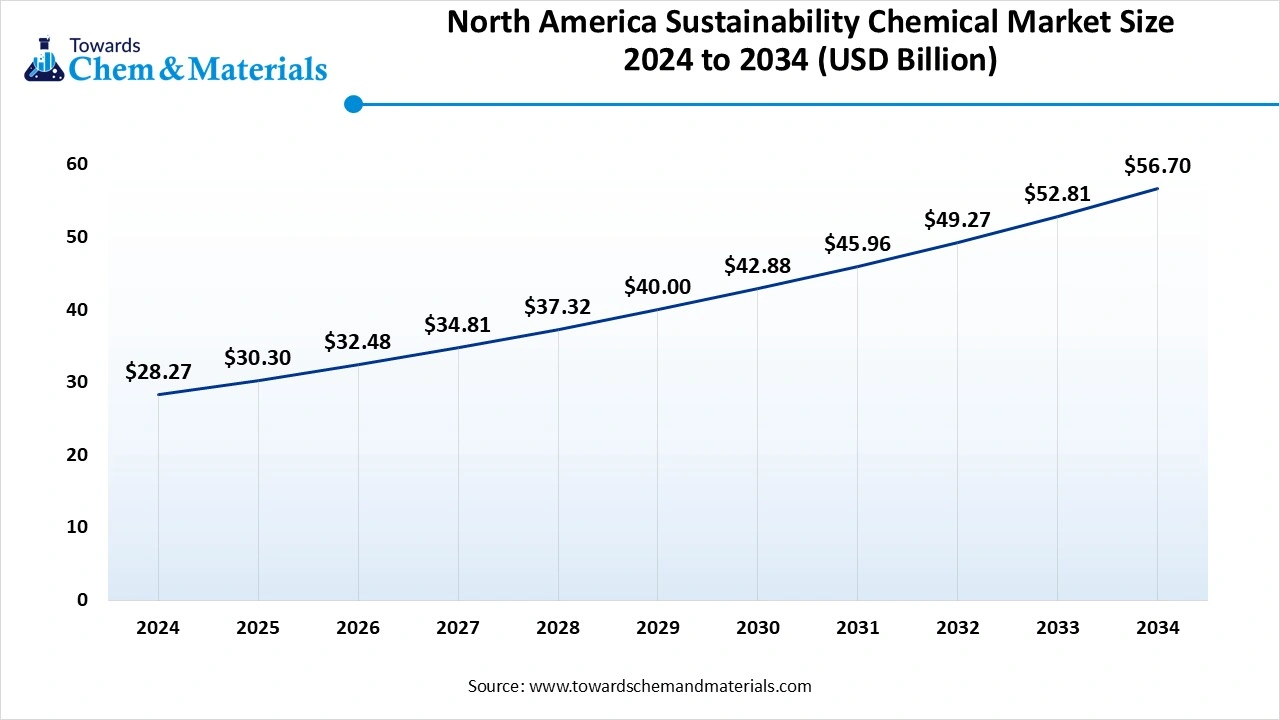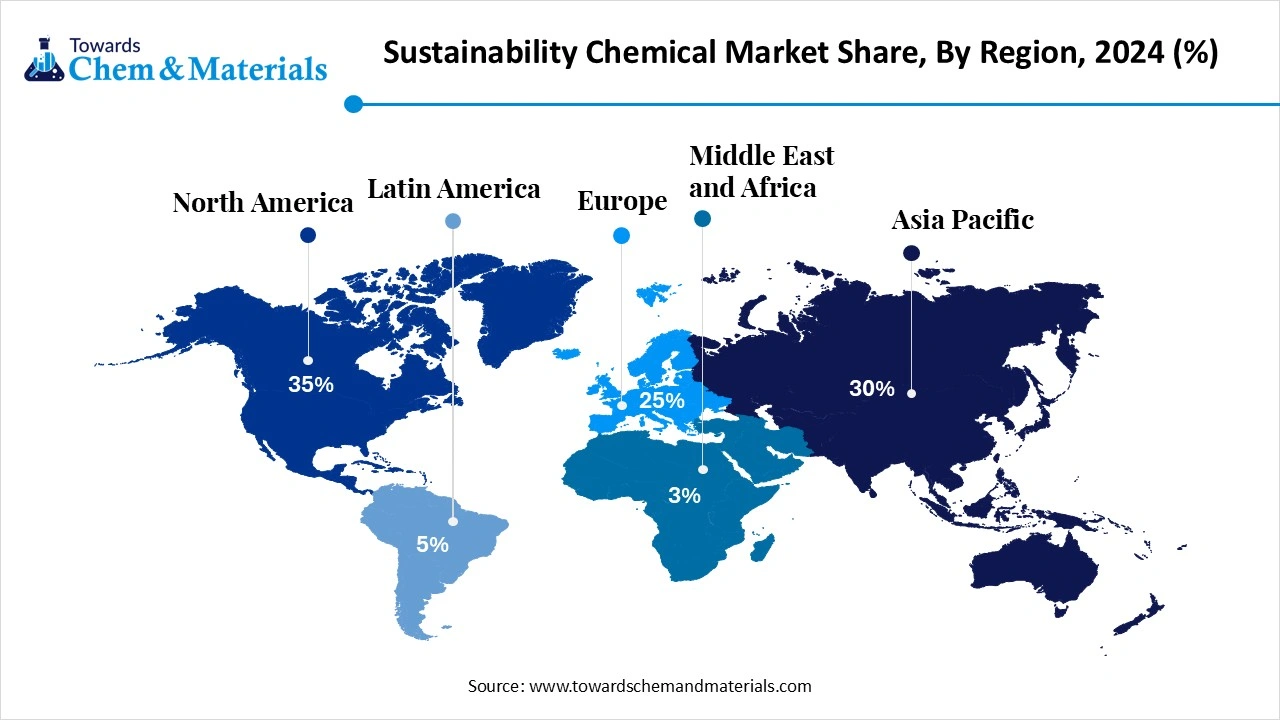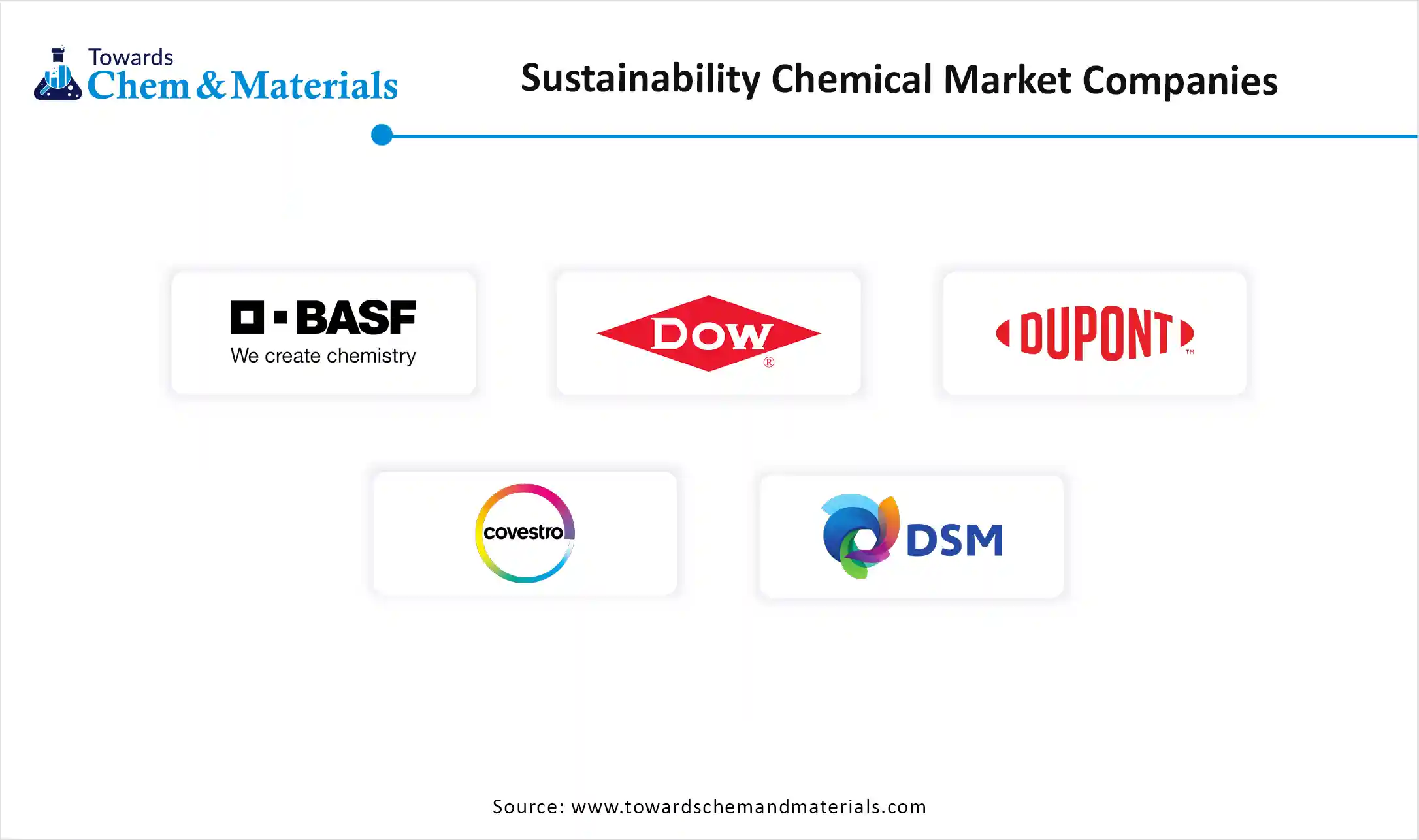November 2025
The global sustainability chemical market size was reached at USD 80.77 billion in 2024 and is expected to be worth around USD 161.73 billion by 2034, growing at a compound annual growth rate (CAGR) of 7.19% over the forecast period 2025 to 2034. Increasing demand for sustainable materials is the key factor driving market growth. Also, growing adoption of renewable resources, coupled with the stringent environmental regulations, can fuel market growth further.

Sustainability chemicals refer to chemicals derived from renewable resources or produced in a manner that has minimal negative impact on the environment. These chemicals are designed to improve environmental efficiency, reduce waste, lower carbon footprints, and promote sustainability in various industries like agriculture, energy, manufacturing, and consumer goods. R&D efforts are important for developing sustainable chemical processes and technologies, boosting market growth further.
| Report Attributes | Details |
| Market Size in 2025 | USD 86.57 Billion |
| Expected Size by 2034 | USD 161.73 Billion |
| Growth Rate from 2025 to 2034 | CAGR 7.19% |
| Base Year of Estimation | 2024 |
| Forecast Period | 2025 - 2034 |
| Dominant Region | North America |
| Segment Covered | By Type, By Application, By End-User Industry, By Product Form, By Chemical Source, By Distribution Channel, By Region |
| Key Companies Profiled | BASF SE, Dow Chemical Company, DuPont de Nemours, Inc., Covestro AG, DSM, Evonik Industries AG, Bayer AG, Huntsman Corporation, Clariant International Ltd., Wacker Chemie AG, Solvay SA, AkzoNobel N.V., Eastman Chemical Company, Lanxess AG, Mitsubishi Chemical Holdings Corporation, SABIC, Sinopec Limited, LG Chem Ltd., LG Household & Health Care, Johnson Matthey PLC |
The rapid transition towards bio-based renewable feedstocks and resources is the major factor creating lucrative opportunities in the market. Furthermore, Green chemicals derived from biomass, agricultural waste, and other renewable materials are increasingly gaining popularity because of their ability to replace conventional, unsustainable chemicals and their less dependence on limited resources.
Traditional chemicals are generally derived from fossil fuels and have a lower manufacturing cost as compared to sustainability chemicals, which can be a major factor hindering market growth. Moreover, many end users may not be aware of the advantages of green chemicals, which makes them hesitant to use these products, especially if they see them as more expensive to adopt.
The North America sustainability chemical market size was estimated at USD 28.27 billion in 2024 and is projected to reach USD 56.70 billion by 2033, growing at a CAGR of 7.21% from 2025 to 2034. North America dominated the market by holding a 35% share in 2024.

The dominance of the region can be attributed to the rising demand for sustainable products and a surge in government initiatives supporting green chemicals. Moreover, a resurgence in domestic production in North America, along with the region's strong infrastructure, is promoting the expansion of the regional market further.
The U.S. Sustainability Chemical Market Trends
In North America, the U.S. led the market due to the ongoing innovations in green chemistry technologies and the growing focus on the circular economy, which aims to reduce waste and maximize resource use. Also, investors in the region are increasingly prioritizing sustainability, which is impacting corporate decisions and propelling investment in green chemical technologies.

Asia Pacific Sustainability Chemical Market Trends
Asia Pacific is expected to grow at the fastest CAGR over the forecast period. The growth of the region can be credited to the increasing demand for bio-based products such as biodegradable polymers, renewable alcohols, and bio-based chemicals in several applications. Furthermore, major players in the region are focusing on sustainability in their production processes, which leads to the adoption of green chemical alternatives.
Which Type Segment Dominated the Sustainability Chemical Market in 2024?
The bio-based chemicals segment dominated the market by holding 40% market share in 2024. The dominance of the segment can be attributed to the increasing global consumption of bio-based products along with the rising need for sustainable alternatives. Also, many governments globally are implementing newer policies and providing incentives to optimize the adoption of bio-based chemicals, further propelling segment growth.
The bio-plastics segment is expected to grow at the fastest CAGR over the forecast period. The growth of the segment can be credited to the rapid shift towards eco-friendly products along with the innovations in bioplastic technologies. In addition, bioplastics offer a much lower carbon footprint as compared to conventional plastics and can be compostable, addressing waste management issues.
Why Agriculture Segment Dominated the Sustainability Chemical Market in 2024?
The agriculture segment held a 30% market share in 2024. The dominance of the segment can be linked to technological innovations, such as precision farming, coupled with the supportive government initiatives and policies. Moreover, the development of advanced, sustainable, and bio-based agrochemicals, along with the efforts to enhance soil health and support food security, also boosts segment expansion.
The water treatment segment is expected to grow at the fastest CAGR over the forecast period. The growth of the segment can be driven by the growing need for clean water and the rise in the shift towards eco-friendly solutions. Industries such as oil & gas, pharmaceuticals, power generation, and food & beverage are major consumers of water, necessitating sustainable and efficient water treatment processes that develop low-VOC alternatives.
How Much Share Did the Automotive Segment Held in 2024?
The automotive segment led the market by holding a 25% share in 2024. The dominance of the segment is owed to the growing demand for sustainable and fuel-efficient vehicles and stringent regulations implemented by governments globally. Furthermore, major manufacturers are emphasizing developing low-VOC, sustainable paints, coatings, and chemicals to improve vehicle aesthetics while reducing the overall environmental impact.
The consumer goods segment is expected to grow at the fastest CAGR during the projected period. The growth of the segment is due to the rapid shift in consumer lifestyles and consumer preference for sustainability. Additionally, innovations in research and development and the rising availability of renewable resources are impacting positive segment growth.
Which Product Form Segment Dominated Sustainability Chemical Market in 2024?
The liquid segment dominated the market by holding a 45% share in 2024. The dominance of the segment can be attributed to the surge in industrial and consumer demand for renewable, safer, and biodegradable alternatives, along with the integration and development of biotechnology and green chemistry to create sustainable liquid chemicals.
The solid segment is expected to grow at the fastest CAGR during the study period. The growth of the segment can be credited to the rapid urbanization, increased industrial activity, and growing focus on sustainable waste management. Also, the adoption of green chemistry initiatives, which emphasize designing safer chemical processes and products, is contributing to segment growth soon.
Why Did the Plant-Based segment Held the Largest Sustainability Chemical Market Share in 2024?
The plant-based chemicals segment led the market by holding 50% market share in 2024. The dominance of the segment can be linked to the ongoing government initiatives supporting green chemistry and innovations in technology. Growing awareness regarding the finite nature of fossil fuels and the desire to minimize dependence on them are fueling the transition towards renewable chemical production.
The synthetic-based chemicals segment is expected to grow at the fastest CAGR over the forecast period. The growth of the segment can be driven by increasing emphasis on green chemistry principles and growing consumer demand for sustainability. Furthermore, the government regulations encourage major players to adopt sustainable practices.
How Much Share Did the Direct Sales Segment Held in 2024?
The direct sales segment held a 60% market share in 2024. The dominance of the segment is owed to the surge in government initiatives supporting green chemicals and rising consumer demand for sustainable products. Also, major players are forming new partnerships and acquiring other businesses to access new technologies and enhance their market position in the industry.
The distributors segment is expected to grow at the fastest CAGR over the forecast period. The growth of the segment is due to the increasing adoption of digital technologies and rising consumer demand for sustainable products. In addition, distributors are expanding their portfolios to include sustainable chemicals by using digital platforms.
Regulatory compliance means adhering to the chemical products. It includes ensuring that products fulfil specific health, safety, and other regulatory requirements before they can be sold or distributed in the market.
In March 2025, C1 Green Chemicals raised €20 million for the decarbonization of the chemical industry, marking a substantial step in the initiative to defossilise the most carbon-emitting sector. Green methanol is stepping up as a major factor in the global decarbonization initiative.(Source: esgnews.com)

By Type
By Application
By End-User Industry
By Product Form
By Chemical Source
By Distribution Channel
By Region
November 2025
November 2025
November 2025
November 2025